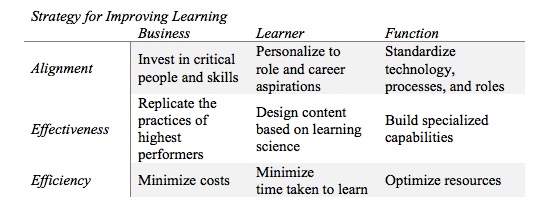
The concepts of alignment, effectiveness, and efficiency have been used for decades as a framework for managing and measuring corporate functions, including Learning. If we look at these outcomes through three lenses—the business, the learner, and the function—we can formulate a strategy for improving corporate learning.

Alignment
Business alignment requires investment in those people (roles, groups) and skills that are most important to executing business strategy. For example, if a company’s growth strategy is to focus on emerging markets, this can justify and, indeed, necessitate differential investment in developing the skills of employees in those countries. If a company is relying on a new product or service to drive growth, then investment in learning opportunities for people responsible for developing and delivering that new product or service should be prioritized.
Learner alignment means learning is assigned to individuals and groups on the basis of their skill gaps for current roles. In addition, we align with the personal career aspirations and interests of the individual by providing access to optional opportunities to build a broad range of skills. For example, a learner can have a prescribed learning plan and open access to entire digital content libraries.
Function alignment means standardizing the infrastructure and operations across the function. For example, a Learning function can be decentralized but have strong internal alignment through common platforms, processes and team roles.
Effectiveness
Business effectiveness results from cloning or replicating the behavior of highest performers. The more learning content covers the thinking and practices of the highest performers in this particular company, rather than general content about the domain, the more effective learning will be for the business.
Learner effectiveness is driven by the instructional design of the content—that is, the amount and type of information, demonstrations, practice, feedback, and reflection activities that are included. The more learning content incorporates methods that have learning science to support them, such as authentic practice, for example, the more people will learn and apply what they learn.
Function effectiveness is determined by the competence of the Learning professionals who work in it. The more those professionals are specialists in areas such as instructional design or learning technology, the more effective the function will be.
Efficiency
Business efficiency is about minimizing the costs to define, design, develop, and deliver learning. For example, we can cut delivery costs by converting from classroom to online delivery of content.
Learner efficiency is about minimizing the time taken to learn. For example, using self-paced delivery for elements of learning that are best done alone can reduce the overall time taken to learn as each individual can spend as little or as much time as he or she needs to complete it. Embedding short learning objects such as reference guides and video demonstrations in workflow to support performance means learning happens “just in time” rather than “just in case.”
The efficiency of the Learning function is influenced by resource optimization. For example, moving learning administration tasks to shared services and automation increases the efficiency of the function.
Ultimately, prioritizing activities with the biggest influence on alignment, effectiveness, and efficiency for the business, the learner, and the Learning function is a practical strategy for improvement.
Brenda Sugrue is Global Chief Learning Officer for EY, a global leader in assurance, tax, transaction, and advisory services. EY is a TrainingTop 10 Hall of Famer. The views reflected in this article are the views of the author and do not necessarily reflect the views of the global EY organization or its member firms.

